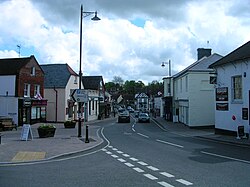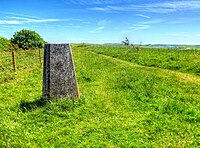Storrington
| Storrington | |
| Sussex | |
|---|---|

| |
| Location | |
| Grid reference: | TQ087142 |
| Location: | 50°55’4"N, 0°27’17"W |
| Data | |
| Post town: | Pulborough |
| Postcode: | RH20 |
| Dialling code: | 01903 |
| Local Government | |
| Council: | Horsham |
| Parliamentary constituency: |
Arundel and South Downs |
Storrington is a small town in Sussex, standing at the foot of the north side of the South Downs. The population was estaimted at 4,600 in 2006.
There is one main shopping street (the High Street). The A283 road runs directly through the village and connects Storrington to Steyning in the east and Pulborough in the west.
Contents
History
Storrington is listed in the Domesday Book as "Estorchestone", meaning 'stork village'. A charter to hold a regular market on Wednesdays was granted by King Henry IV in 1400, together with permissions for three fairs during the year, on Mayday, Wednesday of Whit week and the Feast of Martin on 11 November.[1]
Tanning and blacksmithing were also important industries and only in the 20th century did these roles fade away. Rabbit breeding was another significant industry reflected in a number of local place names including 'The Warren', 'Warren Hill', 'Sullington Warren' and 'Warren Croft'. This working/small industry background has however, left little behind architecturally. Nikolaus Pevsner, noted only the small door in Browns Lane, the church, and the Dominican convent known as the Abbey to be historically significant.
Community
Since 1945 Storrington has expanded with a variety of housing projects which enlarged the village.[2] It is possible to be in open countryside in a few minutes from the town centre when walking towards the downs or one of the commons.
The town has a small range of local shops: a supermarket and such shops as delicatessens, charity shops, butchers, clothes shops, coffee shops, hardware stores, estate agencies, two banks, restaurants and a post office. There are three pubs: The Moon, the Anchor Inn and the White Horse Inn. The town also has a museum.
From the village centre there is walking access to the hundred-mile long South Downs Way walking trail. From Chantry Hill or Kithurst Hill there are views across the English Channel to the south and opposite, to the North Downs. On a clear day you can see the Isle of Wight in [[Hampshire].[3]
Kithurst Hill which rises steeply above the village is marked at the summit by a trig point, 699 feet above sea level.
Sport and leisure
- Cricket
- Football: Storrington F.C., who play at the recreation ground.
Storrington is thinly disguised as the home of the home team in Hugh de Sélincourt's 1924 novel The Cricket Match, complete with chestnut trees and duck pond. In later editions a cartoon map of the village is used as end pages. John Parker wrote what was effectively a sequel in The Village Cricket Match in 1977.[4]
Churches
- Church of England: St Mary's
- Methodist
- Roman Catholic: The Priory of Our Lady of England
- Jehovah's Witnesses
About the village
St Joseph's Hall in Greyfriars Lane is a Grade II listed buildingwhich used to be the residence of the local Roman Catholic (of Arundel and Brighton). It was built as a private house for an American businessman George Trotter in 1910, and then sold to a French religious order, the Norbertines. In 1956 it was used by Vincent and Nona Byrne as a home for refugees from the Hungarian uprising.[5] It is a Grade II listed building.[6]
Parham Park, towards Pulborough, is a country house with rolling parkland with a large herd of maintained deer. It is open most weekends to visitors. There is also the private Edwin Lutyens built Little Thakeham nearby.[7]
Outside links
| ("Wikimedia Commons" has material about Storrington) |
References
- ↑ "Gazetteer of markets and fairs in England and Wales to 1516". http://www.history.ac.uk/cmh/gaz/placeframe.html.
- ↑ "Storrington - At Home Estates". https://www.athomeestates.co.uk/estate-agent-storrington.
- ↑ "Outdoor activities - Storrington: walking, cycling, riding, gliding" (in en-GB). https://www.storrington.org.uk/attractions/outdoor-activities/.
- ↑ "A gentleman's game" (in en). https://www.theargus.co.uk/news/9271369.a-gentlemans-game/.
- ↑ "Tea and sympathy for Bishop". Daily Telegraph. https://www.telegraph.co.uk/news/uknews/1454269/Tea-and-sympathy-for-bishop-with-room-to-spare.html.
- ↑ National Heritage List 1391342: St Joseph's Hall (Grade II listing)
- ↑ National Heritage List 1027209: Little Thakeham (Grade I listing)
